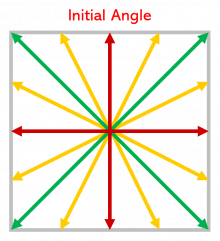Vectoring: Difference between revisions
Expanded Properties and Uses sections |
Added diagram of vectoring angles |
||
| Line 2: | Line 2: | ||
== Properties == | == Properties == | ||
[[File:Vectoring Diagram.png|thumb|241x241px]] | |||
When Mario jumps (does not apply to long jumps), [[Vault|vaults]], rolls, [[Roll cancel|roll cancels]] or falls off the edge of a platform, the game keeps track of the direction in which his jump or fall was initiated. If Mario has enough momentum, his fall can be vectored by moving in any direction that is diagonal from this initial direction (45, 135, 225 or 315 degrees apart). This is most noticeable when falling long distances, where one may be able to notice an invisible square or "box" in which Mario gains more speed at the corners. | When Mario jumps (does not apply to long jumps), [[Vault|vaults]], rolls, [[Roll cancel|roll cancels]] or falls off the edge of a platform, the game keeps track of the direction in which his jump or fall was initiated. If Mario has enough momentum, his fall can be vectored by moving in any direction that is diagonal from this initial direction (45, 135, 225 or 315 degrees apart). This is most noticeable when falling long distances, where one may be able to notice an invisible square or "box" in which Mario gains more speed at the corners. | ||
The diagram at right shows the angles at which vectoring increases velocity by the maximum amount (denoted using green arrows). | |||
Vectoring can even be performed with certain captures, most notably the [[frog|Frog]]. | Vectoring is more noticeable on the surface of the Moon Kingdom, since it is easier to vector individual jumps at a full 45-degree angle. Vectoring can even be performed with certain captures, most notably the [[frog|Frog]]. | ||
== Uses == | == Uses == | ||
Revision as of 05:12, 2 October 2019
Vectoring refers to the manner in which Mario's fall speed is maximized by moving at an angle that is 45 degrees apart from the direction in which the fall was initiated.
Properties

When Mario jumps (does not apply to long jumps), vaults, rolls, roll cancels or falls off the edge of a platform, the game keeps track of the direction in which his jump or fall was initiated. If Mario has enough momentum, his fall can be vectored by moving in any direction that is diagonal from this initial direction (45, 135, 225 or 315 degrees apart). This is most noticeable when falling long distances, where one may be able to notice an invisible square or "box" in which Mario gains more speed at the corners.
The diagram at right shows the angles at which vectoring increases velocity by the maximum amount (denoted using green arrows).
Vectoring is more noticeable on the surface of the Moon Kingdom, since it is easier to vector individual jumps at a full 45-degree angle. Vectoring can even be performed with certain captures, most notably the Frog.
Uses
Vectoring is used at various points in speedruns to gain a small amount of extra speed. Some notable examples of this are vectoring as the Frog inside Top-Hat Tower in the Cap Kingdom, or vectoring triple jumps with momentum on the surface of the Moon Kingdom.
Vectoring is also an essential tool used for almost every trickjump. Certain trickjumps such as Snow Dram and Bruncheon would not be possible without the use of vectoring to majorly increase Mario's falling speed.
